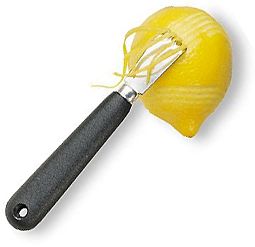|
For several years, I thought that fresh citrus zest and dried
citrus peel were basically the same thing, or at least interchangeable.
I would blow off recipes that called for lime zest because
I could never find lime peel in the bulk section at the grocery
store.
One day, in the midst of cooking, my best friend suggested
that I try her citrus zester. "No, I brought orange peel,"
I said. She grabbed an orange and kind of shook her zester
in my face. "No you need to use my zester." She
had a semi-crazed look in her eyes, so, at her insistence
I used the zester.
As usual, she was right on the money.. "You see! It
has a more intense flavor!" I nodded and agreed. The
citrus skin, I discovered, contains concentrated oil that
is remarkably flavorful, as well as very colorful. I was onboard
with the citrus zester.
 A
citrus zester is simply a 4- or 5- holed stainless steel edge
secured to a handle. Just pull the zester across the desired
citrus, pressing firmly, and tiny strips of peel are produced.
Take care not to press so hard that the white layer underneath,
the pith, is removed. The pith is very bitter and should not
be used unless the recipe calls for it. Also, be sure to zest
your fruits prior to juicing or cutting it. After peeling,
the peel is still usable, but the task is messier and more
time consuming. A
citrus zester is simply a 4- or 5- holed stainless steel edge
secured to a handle. Just pull the zester across the desired
citrus, pressing firmly, and tiny strips of peel are produced.
Take care not to press so hard that the white layer underneath,
the pith, is removed. The pith is very bitter and should not
be used unless the recipe calls for it. Also, be sure to zest
your fruits prior to juicing or cutting it. After peeling,
the peel is still usable, but the task is messier and more
time consuming.
You should be able to zest an entire piece of fruit in less
than a minute. Any extra zest can be stored in the freezer
for up to six months. It's nice to have on hand when you need
a small amount, so go ahead and zest fruits whether you need
the peel immediately or not.
You can find a zester for about $6 - $8 at most grocery
or housewares stores. It may seem pricey since it has only
one function. But, I assure you, it performs that function
better and faster than any other utensil you've got. So splurge
a little and start adding some zest to your cooking.
shown: citrus zester in action, $8.50 from Williams-Sonoma.
 
also: the
Oxo Good Grips Zester ,
$6.50 from Cooking.com ,
$6.50 from Cooking.com
|

